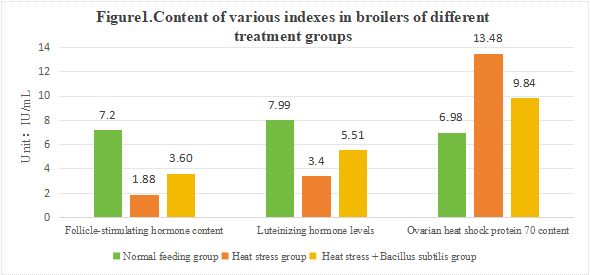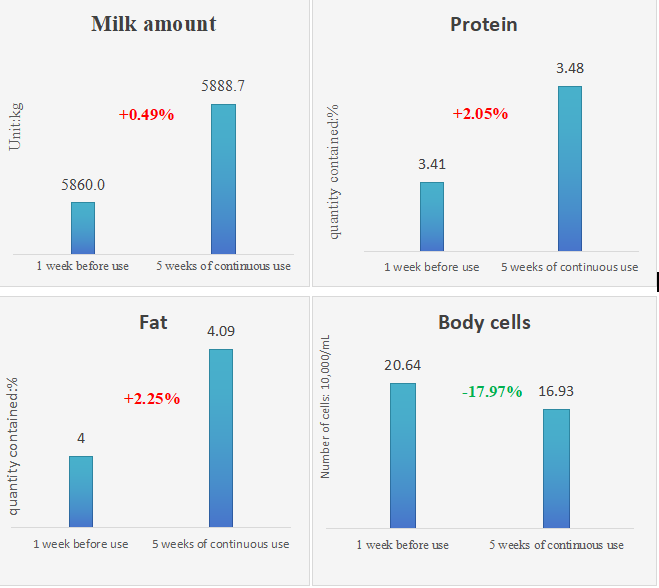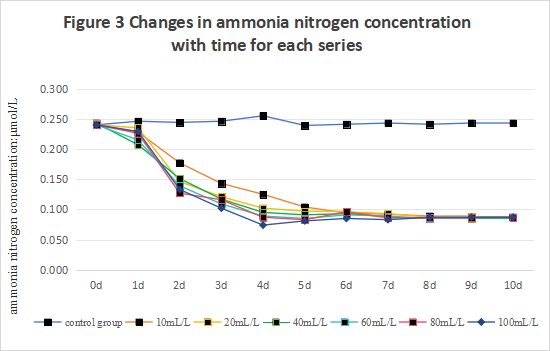Main Ingredients
Bacillus subtilis and its metabolic products, suitable carrier.
Active Bacteria Content
Water-soluble:10 billion cfu/g, 20 billion cfu/g, 50 billion cfu/g, 100 billion cfu/g, 200 billion cfu/g;
Non-water soluble:10 billion cfu/g, 20 billion cfu/g, 50 billion cfu/g, 100 billion cfu/g, 200 billion cfu/g
Product Benefits
Related Applied Research
Experiment I. Effect of Bacillus subtilis on serum follicle-stimulating hormone and luteinizing hormone content in heat-stressed broilers-Feng, Kangmei, 2024
Bacillus subtilis was able to increase the serum levels of follicle-stimulating hormone and luteinizing hormone in hens during heat stress, which helped to alleviate the adverse effects and damage caused by heat stress on ovarian reproductive hormone secretion. Adding a certain dose of Bacillus subtilis to the diet can help alleviate the adverse effects of heat stress on the reproductive performance of broilers.

Note:experimental animals: 120 broilers. 3 groups were normal feeding group, heat stress group, and heat stress+Bacillus subtilis group with 300 mg/kg. the temperature of CON group was controlled at (23±1)℃, and the humidity was about 60%; the temperature of HS group and HS+BS group was controlled at (33±1)℃, and the humidity was about 70%. The pre-feeding period was 21 d (all groups were fed the basal ration), and the heat stress started on the 22nd day (the CON and HS groups were fed the basal ration, and the HS+BS group was added the Bacillus subtilis preparation to the ration), and the temperature of the CON group was controlled at (23±1)℃ and the humidity was about 60%, and the temperature of the HS group and the additives group was controlled at (33±1)℃ and the humidity was about 70%, and the heat stress test period lasted for 21 d.
Experiment II. Application of feed additive Bacillus subtilis on lactating dairy cows - Zhang Bing Sheng, 2022
The use of Bacillus subtilis on lactating dairy cows can improve the health of cows and reduce the number of somatic cells in milk. After feeding Bacillus subtilis to lactating cows, the daily lactation yield can be increased by 1.19 kg. Calculated according to the raw milk price of 4.2 RMB/kg, each lactating cow can earn 5.0 RMB more per day, and after deducting the cost of feeding Bacillus subtilis by 1.8 RMB per day, each dairy cow can earn 3.2 RMB more per day. The increase in milk protein and milk fat rate and the improvement in milk quality brought about by the reduction in somatic cell count will bring more considerable economic benefits to the farm.
Figure 2.Comparison of milk indicators before and after feeding of Bacillus subtilis

Note: Test animals: lactating dairy cows; the number of beneficial live bacteria of Bacillus subtilis used in the test ≥ 1.0×108CFU/g. At the beginning of the test, each cow was fed 60g of Bacillus subtilis per day, and then the amount was adjusted to 40g/cow/day after 1 week of feeding, and then the amount was adjusted to 20g/cow/day after 3 weeks of feeding. After 3 weeks of continuous feeding, the dosage was adjusted to 20 g/head-per-day until the end of the experiment. Test period: 5 weeks.
Experiment Ⅲ. When using Bacillus subtilis to treat water, Bacillus subtilis can have good activity in water containing ammonia nitrogen, and can significantly reduce the ammonia nitrogen content of the water,, and the removal rate of NH3-N in the water quality can be up to 63.75% - Zhang Yunze, 2022

Experiment IV. Effect of Bacillus subtilis bacterial fertilizer on rice yield and soil nutrient content-Ling, Zhilong, 2024
The effects of the application of Bacillus subtilis fertilizer on the economic benefits of rice cultivation are shown in Table 2. As shown in Table 2, T1 treatment, T2 treatment and T3 treatment increased the income by 975.25 RMB/hm2,911.34 RMB/hm2, and -1563.38 RMB/hm2 compared with the CK treatment, respectively.
Table 1.Specific fertilizer application in each treatment group
|
Treatment |
Description |
Rice Compound Fertilizer |
Urea |
Microbial Fertilizer |
|
CK |
Routine local fertilization |
375.00 |
337.5 |
— |
|
T1 |
Conventional local fertilization +Bacillus subtilis fertilizer |
375.00 |
337.5 |
600 |
|
T2 |
90% local conventional fertilization +Bacillus subtilis fertilizer |
337.5 |
303.95 |
600 |
|
T3 |
80% conventional local fertilization +Bacillus subtilis fertilizer |
300 |
270 |
600 |
Table 2 Effect of application of Bacillus subtilis bacterial fertilizer on yield and economic benefits of rice cultivation
|
Treatment |
Yield/(kg/hm2) |
Yield increase over CK/% |
Rank |
Value/(RMB/hm2) |
Fertilizer input/(RMB/hm2) |
Net return/(RMB/hm2) |
|
CK |
8233.27 |
— |
3 |
37049.72 |
2257.50 |
34792.22 |
|
T1 |
8835.79 |
7.32 |
1 |
39941.06 |
4057.50 |
35703.56 |
|
T2 |
8799.95 |
6.88 |
2 |
38924.78 |
3832.31 |
35767.47 |
|
T3 |
8185.52 |
-0.58 |
4 |
36834.84 |
3606.00 |
33228.84 |
Note: The price of rice was 4.5RMB/kg, the price of rice compound fertilizer was 3.5RMB/kg, the price of urea was 2.8RMB/kg, and the price of Bacillus subtilis fertilizer was 3.0RMB/kg.The rice variety used in the experiment was TWY 1606, the rice formula fertilizer used in the experiment [m(N):m(P2O5):m(K2O)=16:11:18], and the microbial fertilizer used in the experiment (containing 200 million/g of Bacillus subtilis).
Packing
25kg/bag
Loading Capacity
Without pallet: 20T/20FCL; with pallet: 16T/20FCL.
Shelf life
Keep cool and dry for 24 months.
Scope of use
1). Adding to whole-value feed, adding to feed additives, adding to premix.
2). Add to the production of bio-organic fertilizer, fermented organic fertilizer.
3). Various kinds of marine and freshwater nursery pools and breeding pools.
4). Urban sewage and landscape water treatment, food waste and animal manure treatment.
Dosage
Calculated by 20 billion CFU/g content, other products can be converted according to the actual content.
1. Dosage in feed supplementation
It can be used in 200-300g/ton feed pelleting, and can also be added evenly into the basic diet or mixed with water for direct drinking (soluble carrier).
2. Dosage in Aquaculture
Dosage: 150-300g/m2 in water, use once in 10-15 days. In case of serious deterioration of water quality, it can be doubled and used once every 5-7 days.
Precautions: Do not use with disinfectant or antibacterial drugs, and pay attention to oxygenation when treating aquaculture water.

Phone: +86-317-2135910
E-mail: Erica@stbiol.com
Address: Machang Town,Qing County ,Cangzhou City ,Hebei,China
Hebei Shuntian biotechnology Co.,Ltd.
Add:Machang Town,Qing County ,Cangzhou City ,Hebei,China
Tel: +86-317-2135910
E-mail:Erica@stbiol.com
© Copyright - 2018-2020 : All Rights Reserved.